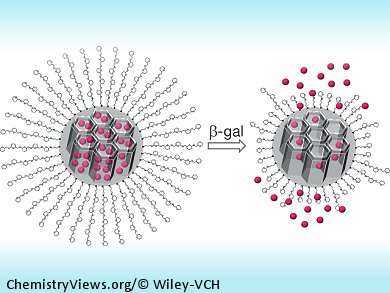Spanish researchers have prepared microporous silica nanoparticles capped with galacto-oligosaccharides as a cargo release system specific for senescent cells. These are cells with an altered phenotype that are not completely destroyed by the immune system and thus accumulate in tissue over time. The strategy reported by Ramón Martínez-Máñez, University of Valencia, Rosario Perona, Institute for Biomedical Research, Madrid, José Ramón Murguía, Joint Institute of Molecular and Cell Biology of Plants, Valencia, and their respective co-workers allows senescent cells to be targeted as the galacto-oligosaccharide caps are a substrate of senescence-associated β-galactosidase.
In the presence of senescent cells, the enzyme hydrolyzes the cap, thus releasing the cargo. The researchers used Rhodamine B as a model drug and studied its release in both in vitro and in vivo experiments. The nanoparticles were internalized in all cell types studied, but released their cargo only in β-galactosidase overexpressing cells.
This is the first example of the selective targeting of senescent cells with nanoparticles and may become an effective strategy in the treatment of age-related diseases.
- Targeted Cargo Delivery in Senescent Cells Using Capped Mesoporous Silica Nanoparticles,
Alessandro Agostini, Laura Mondragón, Andrea Bernardos, R. Martinez Manez, M. Dolores Marcos, Félix Sancenón, Juan Soto, Cristina Manguan-García, Rosario Perona, Marta Moreno-Torres, José Ramón Murguía,
Angew. Chem. Int. Ed. 2012.
DOI: 10.1002/anie.201204663 - Angew. Chem. 2012.
DOI: 10.1002/ange.201204663



